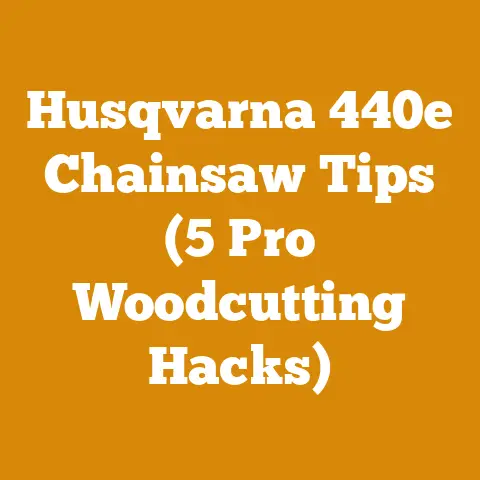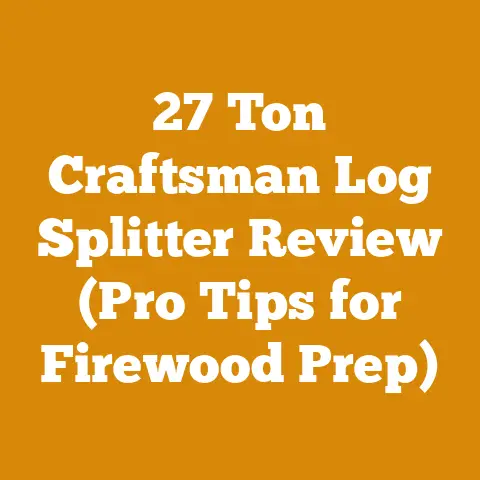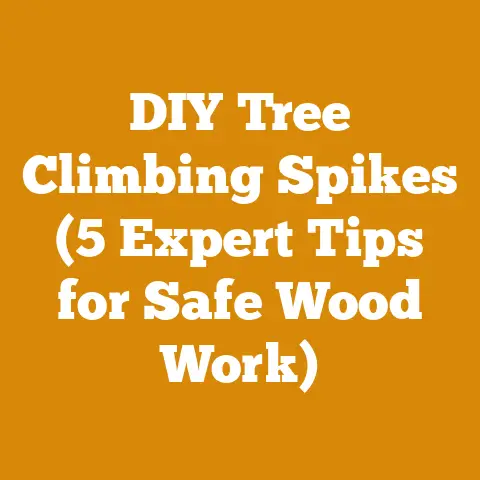Shrub Remover Tips for Wood Processing (5 Pro Arborist Secrets)
Have you ever stood at the edge of a tangled wilderness, a riot of overgrown shrubs threatening to swallow your carefully planned wood processing operation, feeling utterly overwhelmed? I have. I remember one particularly brutal summer in the Pacific Northwest. I had a contract to clear a section of land for a sustainable timber harvest, and the undergrowth was a monster – choking young trees, hindering access, and generally making my life a living, breathing nightmare. It felt like I was wrestling a hydra, every shrub I cut down seemed to sprout two more in its place. That experience, and countless others since, has taught me that effective shrub removal isn’t just about brute force; it’s about strategy, technique, and a deep understanding of the land.
Shrub Remover Tips for Wood Processing (5 Pro Arborist Secrets)
1. Know Thy Enemy: The Art of Shrub Identification & Assessment
Before you even think about firing up your chainsaw or reaching for your loppers, the first secret is to understand exactly what you’re dealing with. Proper shrub identification is absolutely crucial. It’s not just about knowing the name of the plant; it’s about understanding its growth habits, root systems, and potential hazards.
-
Why Identification Matters: Different shrubs respond differently to removal methods. Some are shallow-rooted and easy to pull out, while others have deep, tenacious roots that require more aggressive techniques. Knowing the species also alerts you to potential dangers, like poisonous plants (poison ivy, poison oak, etc.) or thorny varieties.
-
How to Identify Shrubs: Invest in a good field guide specific to your region. There are also excellent apps available for smartphones that use image recognition to identify plants. Pay attention to leaf shape, flower structure, bark texture, and overall growth habit.
-
Assessing the Situation: Once you know what you’re dealing with, conduct a thorough assessment of the area. Consider the following:
- Density of the shrub growth: Is it a light scattering or a dense thicket?
- Size of the shrubs: Are they small seedlings or mature, established plants?
- Proximity to valuable trees: Are you trying to protect desirable trees from damage?
- Soil conditions: Is the soil loose and easily worked, or compacted and rocky?
- Terrain: Is the area flat, sloped, or uneven?
-
Example: Let’s say you’re dealing with Himalayan blackberry (a common invasive species in many parts of the world). Knowing that it spreads aggressively through underground rhizomes and thorny canes informs your removal strategy. You’ll need to focus on removing the root system to prevent regrowth and wear appropriate protective gear to avoid injury.
-
Data Point: Studies have shown that proper plant identification and targeted removal strategies can reduce herbicide use by up to 40% in forest management. This not only saves money but also minimizes environmental impact.
Personal Story: Early in my career, I made the mistake of underestimating the tenacity of Scotch broom. I thought a quick mowing would take care of it. Big mistake! It came back with a vengeance, even thicker than before. I learned the hard way that effective shrub removal requires understanding the plant’s biology and employing the right techniques.
2. The Right Tools for the Job: Selecting and Maintaining Your Arsenal
The second secret is having the right tools for the job and, just as importantly, keeping them in top condition. Using the wrong tool can be frustrating, inefficient, and even dangerous.
-
Essential Shrub Removal Tools:
- Chainsaw: For larger shrubs and saplings (choose the right size saw for the job – don’t use a massive saw for small shrubs).
- Brush cutter/Clearing saw: Ideal for cutting through dense undergrowth and smaller shrubs.
- Loppers: For cutting branches and stems up to a few inches in diameter.
- Hand pruners: For smaller, more delicate work.
- Shovels and Pulaski: For digging out roots and removing entire plants.
- Weed wrench: A specialized tool for pulling out shrubs, especially those with taproots.
- Gloves, eye protection, and appropriate clothing: Safety first!
-
Tool Maintenance is Paramount: A dull blade is a dangerous blade. Sharpen your chainsaw and loppers regularly. Keep your shovels and Pulaski clean and free of rust. A well-maintained tool is not only safer but also more efficient.
-
Chainsaw Selection for Shrub Removal: Consider a lightweight chainsaw with a shorter bar (14-16 inches) for increased maneuverability in tight spaces. Battery-powered chainsaws are becoming increasingly popular for their ease of use and reduced noise.
-
Brush Cutter/Clearing Saw Considerations: These are powerful tools, so proper training and safety precautions are essential. Choose a model with a comfortable harness and anti-vibration features to reduce fatigue.
-
Data Point: A study by the USDA Forest Service found that using properly sharpened chainsaws can increase productivity by 20% and reduce the risk of kickback injuries.
Personal Story: I once tried to remove a patch of dense brush with a dull chainsaw. It was a nightmare. The saw kept binding, the work was slow and exhausting, and I nearly lost control of the saw several times. After that experience, I made it a point to invest in quality sharpening tools and learn how to properly maintain my equipment.
3. The Strategic Attack: Planning Your Shrub Removal Operation
The third secret is to approach shrub removal with a strategic plan. Don’t just start hacking away randomly. A well-thought-out plan will save you time, effort, and potential headaches down the road.
-
Define Your Objectives: What are you trying to achieve with shrub removal? Are you clearing land for a new wood processing area, improving access to existing timber stands, or simply reducing fire risk? Clearly defining your objectives will help you prioritize your efforts.
-
Prioritize Areas: Focus on the areas that are most critical to your wood processing operation. This might include access roads, log landing zones, or areas where you plan to stack firewood.
-
Consider the Season: The best time to remove shrubs depends on the species and your climate. In general, fall and winter are good times to remove shrubs because the plants are dormant, and the ground is often easier to work. However, some shrubs are easier to identify and remove when they are in leaf.
-
Establish a Work Zone: Clearly mark the area you plan to clear. This will help you stay focused and avoid accidentally damaging valuable trees or other plants.
-
Plan Your Approach: Decide on the best method for removing the shrubs. Will you be using a chainsaw, brush cutter, or hand tools? Will you be removing the entire plant, including the roots, or just cutting it back?
-
Disposal Plan: How will you dispose of the removed shrubs? Will you be chipping them, burning them (if permitted), or hauling them away? Make sure you have a plan in place before you start working.
-
Workflow Optimization:
- Staging Areas: Designate areas for temporary storage of cut shrubs and logs to prevent clutter and maintain clear pathways.
- Directional Felling: If using a chainsaw, plan the direction of your cuts to fell shrubs away from valuable trees and towards designated disposal areas.
- Consistent Communication: If working with a team, establish clear communication signals and hand signals to ensure everyone is aware of potential hazards and the overall plan.
-
Case Study: I once worked on a project where we had to clear a large area of land for a new sawmill. We spent a week carefully planning the operation, identifying the different types of shrubs, prioritizing the areas to be cleared, and establishing a detailed disposal plan. As a result, we were able to complete the project on time and under budget, with minimal environmental impact.
Personal Story: I remember one time when I didn’t plan my shrub removal operation properly. I just started cutting without thinking about where the shrubs would fall. I ended up creating a huge pile of brush that blocked access to my log landing zone. It took me hours to clear the mess, and I learned a valuable lesson about the importance of planning.
4. Mastering the Techniques: Safe and Effective Shrub Removal Methods
The fourth secret is to master the techniques for safe and effective shrub removal. This involves knowing how to use your tools properly, protecting yourself from injury, and minimizing environmental impact.
-
Chainsaw Safety:
- Wear appropriate PPE: This includes a helmet, eye protection, hearing protection, gloves, chaps, and sturdy boots.
- Maintain a firm grip on the saw: Use both hands and keep your thumbs wrapped around the handles.
- Be aware of kickback: Never cut with the tip of the bar.
- Clear the area around you: Remove any obstacles that could cause you to trip or lose your balance.
- Never cut above your head: This is extremely dangerous.
- Take frequent breaks: Chainsaw work is physically demanding.
-
Brush Cutter/Clearing Saw Techniques:
- Use a harness: This will distribute the weight of the tool and reduce fatigue.
- Maintain a wide stance: This will provide stability.
- Swing the tool in a controlled manner: Avoid jerky movements.
- Be aware of the debris: Wear eye protection and be careful not to hit rocks or other objects.
-
Hand Tool Techniques:
- Use the right tool for the job: Don’t try to cut a large branch with hand pruners.
- Keep your tools sharp: A dull tool is more likely to slip and cause injury.
- Use proper body mechanics: Lift with your legs, not your back.
- Take frequent breaks: Hand tool work can be surprisingly tiring.
-
Root Removal:
- Dig around the base of the plant: Expose the main roots.
- Cut the roots with a shovel or Pulaski: Work your way around the plant, severing the roots.
- Pull the plant out of the ground: Use a weed wrench or your hands (with gloves) to pull the plant out.
- Dispose of the roots properly: This will prevent regrowth.
-
Minimizing Environmental Impact:
- Avoid using herbicides: If possible, use mechanical methods to remove shrubs.
- Protect valuable trees: Be careful not to damage the bark or roots of desirable trees.
- Minimize soil disturbance: Avoid excessive digging or tilling.
- Replant native species: This will help to restore the ecosystem.
-
Data Point: Studies have shown that using proper body mechanics and ergonomic tools can reduce the risk of back injuries by up to 50% in forestry work.
Personal Story: I once saw a logger get seriously injured because he was using a chainsaw without wearing proper PPE. He lost control of the saw, and it kicked back and cut his leg. It was a painful reminder of the importance of safety.
5. The Long Game: Preventing Regrowth and Maintaining Your Progress
The fifth and final secret is to play the long game. Shrub removal is not a one-time event; it’s an ongoing process. To maintain your progress, you need to prevent regrowth and regularly monitor your work area.
-
Remove the Root System: As mentioned earlier, removing the entire root system is crucial to prevent regrowth. Many shrubs can resprout from even small pieces of root left in the ground.
-
Mulching: Applying a thick layer of mulch around the base of newly cleared areas can help to suppress weed growth and retain moisture in the soil.
-
Planting Native Species: Planting native groundcover or shrubs can help to outcompete unwanted vegetation and create a more desirable ecosystem.
-
Regular Monitoring: Regularly inspect your work area for signs of regrowth. Catching new sprouts early is much easier than dealing with a large, established shrub.
-
Follow-up Treatments: If regrowth does occur, be prepared to take action. This might involve hand-pulling, cutting back, or, as a last resort, applying herbicide.
-
Controlled Burning (if appropriate and permitted): In some cases, controlled burning can be an effective way to manage shrub growth and reduce fire risk. However, it’s crucial to obtain the necessary permits and follow strict safety guidelines.
-
Sustainable Timber Sourcing:
- Selective Harvesting: Implementing selective harvesting practices that target mature or diseased trees while leaving younger trees to thrive helps maintain a healthy forest ecosystem and reduces shrub encroachment.
- Reforestation: Actively replanting harvested areas with native tree species helps to quickly re-establish a forest canopy, shading out competing shrubs and reducing the need for extensive shrub removal in the long term.
- Minimizing Soil Disturbance: Employing low-impact logging techniques, such as using tracked equipment instead of wheeled vehicles, minimizes soil compaction and erosion, which can create favorable conditions for shrub growth.
-
Data Point: Studies have shown that regular monitoring and follow-up treatments can reduce the need for herbicide use by up to 75% over the long term.
Personal Story: I once cleared a large area of land for a firewood operation, but I didn’t do a good job of preventing regrowth. Within a year, the area was overrun with weeds and shrubs. It took me several years to get the situation under control.
Quote: “The best time to plant a tree was 20 years ago. The second best time is now.” This quote applies equally well to shrub removal. The sooner you start, the easier it will be to maintain your progress.
Workflow Optimization for Long-Term Management:
- Create a Shrub Management Calendar: Schedule regular inspections (e.g., quarterly) and follow-up treatments to ensure consistent maintenance.
- Document Your Efforts: Keep a record of the areas you’ve cleared, the methods you’ve used, and the results you’ve achieved. This will help you track your progress and identify areas that need more attention.
- Adapt Your Strategy: Be prepared to adjust your strategy as needed. Different shrubs will respond differently to different treatments.
Conclusion: Reclaiming Your Wood Processing Space
Shrub removal in wood processing environments is a challenging but essential task. By following these five pro arborist secrets – understanding the shrubs you’re dealing with, using the right tools, planning your operation strategically, mastering safe and effective techniques, and playing the long game – you can reclaim your workspace, optimize your workflow, and achieve your goals more efficiently and safely. Remember, it’s not just about cutting down shrubs; it’s about creating a sustainable and productive wood processing operation for the long term.
Key Takeaways:
- Identify, Assess, Plan, Execute, Maintain: This is the mantra of effective shrub removal.
- Safety First: Always prioritize safety when working with chainsaws, brush cutters, and other tools.
- Prevention is Key: Removing the root system and preventing regrowth is crucial for long-term success.
- Sustainability Matters: Choose sustainable timber sourcing and removal methods to minimize environmental impact.
- Continuous Improvement: Regularly evaluate your strategy and adapt as needed.
Next Steps:
- Identify the shrubs in your work area: Use a field guide or smartphone app to identify the species.
- Assess the situation: Evaluate the density, size, and location of the shrubs.
- Develop a shrub removal plan: Prioritize areas, choose the right tools, and plan your disposal strategy.
- Start clearing! Follow safe and effective techniques, and remember to remove the root system.
- Monitor your work area regularly: Look for signs of regrowth and take action as needed.
Now, get out there and reclaim your wood processing space! I’m confident that with these strategies in hand, you’ll be able to tackle even the most challenging shrub removal projects. And remember, I’m always here to share my experience and help you succeed. Happy processing!






